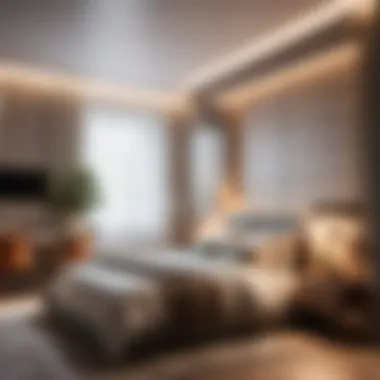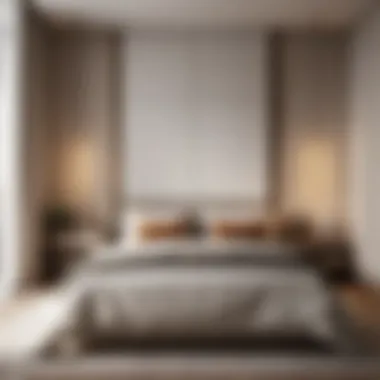Mastering Small Bedroom Optimization: Space and Style Enhancements


Materials:
- 3 sets of wall-mounted shelves (each measuring 24 inches by 12 inches)
- 2 sets of under-bed storage containers (dimensions: 36 inches by 18 inches)
- 1 foldable wall desk (size: 40 inches by 20 inches)
- 1 full-length mirror (dimension: 60 inches by 24 inches)
- 1 set of wall hooks (pack of 5)
- 1 set of drawer organizers (6 pieces)
- Paint (color of choice)
- Paintbrushes
- Drill
- Screws
- Screwdriver
- Tape measure
- Level
- Pencil
DIY Steps:
- Wall-mounted Shelves Installation:
- Under-Bed Storage Assembly:
- Foldable Wall Desk Setup:
- Full-Length Mirror Mounting:
- Wall Hooks and Drawer Organizers:
- Measure and mark positions for shelves, ensuring they are equidistant and at a suitable height.
- Use the drill to attach brackets securely to the wall, then place shelves on top.
- Assemble storage containers according to instructions provided.
- Slide containers under the bed to maximize hidden storage space.
- Mount the wall desk following manufacturer guidelines, ensuring stability and strength.
- Fold down the desk surface to check functionality.
- Locate a sturdy wall space for the mirror and mark mounting points.
- Securely attach the mirror to the wall using appropriate hardware.
- Install wall hooks for hanging items like bags or jackets.
- Arrange drawer organizers to segment and maximize drawer space for organization.
Technical Aspects:
- Tools: Ensure drill bits match screw sizes for secure installations. Use a level for accuracy in shelf and mirror placements.
- Timing: Allocate a weekend for completing all tasks to allow for paint drying and adjustments.
- Key Techniques: Pre-drill holes for screws to prevent wall damage. Use a level to ensure straight installations.
DIY Project Process:
- Sequence of Steps: Start by decluttering the bedroom to create more working space. Begin installing shelves, followed by under-bed storage to maximize floor usage.
- Troubleshooting Tips: If shelves seem unstable, reinforce brackets with extra screws. In case of misaligned wall hooks, measure again before drilling.
This detailed guide ensures a thorough execution of optimizing small bedrooms for space efficiency and style, catering to the needs of housewives and homeowners seeking practical yet elegant solutions.
Introduction
Small bedrooms present a unique set of challenges when it comes to optimizing space while maintaining style and functionality. This article aims to delve deep into effective strategies for maximizing space and infusing design elements to create inviting retreats from planning to execution.
Understanding the Challenges of Small Bedrooms
Limited Space Constraints
In small bedrooms, limited space is a fundamental challenge that must be overcome to create a harmonious balance between functionality and aesthetics. The restricted area poses constraints on furniture placement, storage options, and overall design possibilities. Despite these challenges, limited space constraints offer an opportunity for innovative solutions like sleek modular furniture and space-saving fixtures that can enhance the room's functionality without compromising style.
Need for Creative Solutions
The need for creative solutions in small bedrooms arises from the necessity to optimize every inch of space effectively. It prompts inhabitants to think outside the box and explore unconventional design ideas to maximize storage, comfort, and visual appeal. By embracing creativity, individuals can transform cramped quarters into cozy havens by utilizing underutilized spaces such as vertical nooks or alcoves. Creative solutions not only resolve spatial limitations but also add unique character and charm to the room.
Importance of Efficient Design in Small Spaces


Efficient design is paramount in small bedrooms as it lays the foundation for optimal space utilization and aesthetic harmony. With a focus on functionality and practicality, efficient design ensures that every element serves a purpose and contributes to the overall visual cohesion of the room. By prioritizing smart design choices such as multifunctional furniture pieces and streamlined layouts, small spaces can feel more spacious and inviting. Effective design also enhances the room's versatility, allowing it to adapt to various needs and preferences while maintaining a sense of style and sophistication.
Space Optimization Techniques
In the realm of small bedroom design, mastering space optimization techniques is paramount to achieving a harmonious balance between functionality and style. By strategically employing furniture and storage solutions, one can transform a compact space into a multifunctional haven. The careful selection and placement of each element play a pivotal role in maximizing the available area while ensuring a visually appealing ambiance. Integrating space optimization techniques not only enhances the room's aesthetic appeal but also improves its practicality.
Utilizing Multifunctional Furniture
Convertible Sofa Beds
When delving into the realm of small bedroom optimization, convertible sofa beds emerge as a versatile and space-saving solution. These innovative pieces of furniture seamlessly transition from a comfortable seating area during the day to a cozy sleeping space at night. The key characteristic of convertible sofa beds lies in their dual functionality, serving as both a sofa and a bed, perfect for maximizing limited space in small bedrooms. The unique feature of these convertible pieces is their ability to transform with minimal effort, allowing for easy adaptation to varying needs. While their space-saving benefits are undeniable, it's essential to consider factors like comfort and durability when opting for convertible sofa beds in small bedroom designs.
Wall-Mounted Desks
Wall-mounted desks contribute significantly to space optimization in small bedrooms by minimizing floor clutter and creating a functional workspace. The key characteristic of wall-mounted desks is their ability to provide a designated work area without occupying valuable floor space, making them a popular choice for compact room layouts. This furniture piece's unique feature lies in its ability to be folded or tucked away when not in use, further maximizing room flexibility. While wall-mounted desks are ideal for small bedrooms seeking to blend practicality with style, it's essential to consider ergonomic design and adequate support to ensure comfortable usage.
Maximizing Vertical Space
Floating Shelves
Maximizing vertical space through floating shelves offers a stylish and efficient storage solution for small bedrooms. The key characteristic of floating shelves is their ability to create additional storage without encroaching on floor space, making them a favored option for compact room designs. The unique feature of floating shelves lies in their visually light and airy appearance, adding a touch of modern elegance to the room while serving a functional purpose. Despite their space-saving advantages, it's crucial to consider weight capacity and proper installation to ensure the shelves can safely hold essentials. Floating shelves are an excellent choice for small bedrooms aspiring to combine practicality with aesthetic appeal.
Tall Storage Units
Tall storage units play a crucial role in maximizing vertical space by offering ample storage capacity while utilizing minimal floor area. The key characteristic of tall storage units is their ability to accommodate various items, from clothing to accessories, in a compact footprint, making them an efficient storage solution for small bedrooms. The unique feature of tall storage units lies in their height, allowing for vertical organization and easy accessibility to stored items. When opting for tall storage units, considerations such as accessibility, stability, and compatibility with the room's design aesthetic are essential for ensuring both functionality and visual appeal. Overall, incorporating tall storage units in small bedroom layouts enhances storage efficiency while optimizing vertical space.
Lighting and Color Schemes
In the realm of optimizing small bedrooms, choosing the right lighting and color schemes plays a pivotal role in enhancing the space's functionality and aesthetics. The strategic utilization of lighting fixtures and color combinations can significantly impact the perception of space while creating a harmonious and inviting atmosphere. When discussing lighting and color schemes within this article, it is imperative to delve into specific elements that contribute to transforming small bedrooms into cozy retreats.
Incorporating Natural Light Sources
Incorporating natural light sources is a fundamental aspect of small bedroom optimization. Natural light not only brightens up the space but also creates a sense of openness and airiness. By strategically placing windows, skylights, or utilizing light-filtering curtains, homeowners can maximize the entry of natural light, thereby reducing the reliance on artificial lighting during the day. This approach not only saves energy but also fosters a connection with the outdoors, bringing a touch of nature into the bedroom.
Optimal Lighting Fixtures
LED Track Lights
LED track lights offer a versatile and energy-efficient solution for illuminating small bedrooms. Their sleek design and directional lighting capabilities make them a popular choice for highlighting specific areas or artworks within the room. The key characteristic of LED track lights lies in their adjustable nature, allowing users to customize the direction and intensity of the light to suit different tasks or moods. This adaptability makes LED track lights a beneficial choice for small bedrooms, where targeted lighting can enhance functionality without overwhelming the space. Despite their advantages, it's essential to consider the slightly higher initial cost of LED track lights compared to traditional fixtures.
Sconces
Sconces are another optimal lighting fixture for small bedrooms, known for their space-saving design and decorative appeal. These fixtures can be mounted on walls, saving valuable floor space while adding a touch of elegance to the room. The key characteristic of sconces lies in their ability to provide ambient lighting without occupying surface areas, making them ideal for creating a cozy ambiance in compact spaces. The unique feature of sconces is their versatility in design, ranging from modern minimalist styles to intricate traditional patterns. While sconces offer excellent atmospheric lighting, they may not provide the same level of task lighting as LED track lights, necessitating a balanced approach when incorporating them into small bedroom lighting schemes.
Choosing Light Reflective Colors


When selecting color schemes for small bedrooms, opting for light-reflective colors can amplify the perception of space and luminosity within the room. Colors like soft whites, pastel shades, and light neutrals have the ability to bounce natural and artificial light, creating a sense of openness and airiness. Integrating light-reflective colors on walls, ceilings, and furniture surfaces can visually expand the boundaries of the room, making it feel more spacious and welcoming. Moreover, these color choices complement natural light sources, enhancing their brightness and overall impact on the room's ambiance.
Functional Layout Arrangements
Functional layout arrangements play a crucial role in optimizing small bedrooms by maximizing space utilization and enhancing the overall aesthetic appeal. When it comes to small spaces, every square inch counts, making strategic bed placement essential. By carefully planning the layout, it is possible to create a sense of openness and functionality even in compact areas.
Bed Placement Strategies
Floating Bed Design
Floating bed designs are a stellar choice for small bedrooms as they create an illusion of space by elevating the bed off the floor. This innovative design feature not only adds a modern touch but also provides storage space underneath, enhancing functionality. The key characteristic of floating bed designs is their minimalistic and sleek appearance, making them a popular choice for contemporary room settings. One significant advantage of floating beds is their ability to visually expand the room, giving the impression of a larger area. However, a potential drawback is the limitation on weight capacity compared to traditional beds, which should be considered based on individual needs and preferences.
Loft Beds
Loft beds are another excellent option for optimizing space in small bedrooms. By utilizing vertical space, loft beds free up floor space that can be utilized for other purposes such as a study area or additional storage. The key characteristic of loft beds is their elevated sleeping platform, which allows for the creation of a functional space underneath. Loft beds are beneficial for maximizing space efficiency while offering a sense of coziness and privacy in the sleeping area. One unique feature of loft beds is the versatility they offer, allowing for customization with built-in desks, shelves, or seating options. However, one consideration with loft beds is ensuring safety, especially for children or individuals with mobility issues, as accessing the sleeping area requires climbing up a ladder or stairs.
Creating Visual Zones
Creating visual zones within a small bedroom is essential for optimizing both functionality and aesthetics. By defining distinct areas for different activities, such as sleeping, working, or relaxation, visual zones help in organizing the space effectively. Establishing visual zones can be achieved through the strategic placement of furniture, rugs, or room dividers to delineate areas for specific purposes. This approach not only enhances the visual appeal of the room but also creates a sense of order and balance. Consideration should be given to ensuring that each visual zone seamlessly transitions into the next, maintaining a harmonious overall design.
Stylish Design Elements
In the realm of small bedroom optimization, stylish design elements play a pivotal role in elevating the overall aesthetic appeal and functionality of the space. Incorporating thoughtful and well-curated design elements can transform a cramped room into a stylish sanctuary that exudes charm and sophistication. From furniture choices to decorative accents, every detail contributes to the harmonious blend of style and practicality in a compact setting.
One of the key benefits of integrating stylish design elements in a small bedroom is the ability to create an illusion of space. Strategic placement of furniture, use of light colors, and incorporation of visually appealing décor all work in unison to open up the room and make it feel more expansive. Additionally, a well-designed space enhances the mood and ambiance, creating a retreat-like atmosphere that promotes relaxation and rejuvenation.
When considering stylish design elements for small bedrooms, it is essential to prioritize functionality without compromising on aesthetics. Opt for sleek and modern furniture pieces with built-in storage solutions to maximize space efficiency. Experiment with textures, finishes, and patterns to add depth and visual interest to the room while maintaining a cohesive design scheme.
Furthermore, striking a balance between minimalism and sophistication is key to achieving a stylish look in a small bedroom. Embrace clean lines, understated elegance, and a clutter-free environment to foster a sense of calm and harmony. By infusing your personal style with timeless design elements, you can create a chic and inviting space that reflects your personality and taste.
Minimalist Aesthetic
Embracing a minimalist aesthetic in small bedrooms can be a transformative design choice that enhances the functionality and visual appeal of the space. The minimalist approach focuses on simplicity, clean lines, and a clutter-free environment, creating a sense of tranquility and sophistication.
One of the core principles of a minimalist aesthetic is decluttering and maximizing space utilization. By reducing unnecessary items and furniture, you can create an open and airy atmosphere that feels spacious and unobstructed. Opt for multifunctional furniture pieces that serve dual purposes to streamline the room and minimize visual distractions.
Incorporating a minimalist color palette such as neutral tones, whites, and soft pastels can contribute to a sense of serenity and cohesion in the bedroom. Pairing simple yet elegant furnishings with subtle textures and pops of color can add warmth and interest to the space without overwhelming the senses.
Additionally, embracing minimalist decor accessories such as geometric artwork, simple lighting fixtures, and potted plants can impart personality and character to the room while adhering to the less-is-more philosophy. Creating a serene and clutter-free environment through a minimalist aesthetic fosters a peaceful retreat where you can unwind and recharge.
Incorporating Textures and Patterns
Textural richness and intricate patterns can elevate the design aesthetics of a small bedroom, adding depth, visual interest, and a touch of luxury. Incorporating a variety of textures and patterns in decor elements lends a bespoke charm to the space while creating a sensory experience that engages the senses.
When incorporating textures in a small bedroom, consider layering different materials such as cozy blankets, plush rugs, velvet cushions, and knitted throws to create a tactile and inviting environment. Mix and match textures to introduce contrast and dimension, balancing soft and rough surfaces to create a visually appealing composition.


Pairing subtle patterns with solid colors can add a dynamic element to the room without overwhelming the limited space. Opt for geometric prints, floral motifs, or stripes in moderation to create focal points and infuse personality into the design. Additionally, incorporating textured wall coverings, such as woven wallpapers or textured paint finishes, can create a tactile backdrop that enhances the overall ambiance.
By artfully combining textures and patterns in strategic areas, you can transform a small bedroom into a cozy haven that reflects your style and sophistication. The interplay of different tactile elements adds character and depth to the space, making it a visually engaging and enriching retreat.
Customized Wall Art
Integrating customized wall art in a small bedroom serves as a personalized and impactful design element that enhances the aesthetic appeal and individuality of the space. From bespoke artwork to DIY creations, customized wall art allows you to infuse your personality and creativity into the room, making it truly unique and inspiring.
One of the key advantages of customized wall art is the ability to tailor the design to suit your preferences and complement the overall decor theme. Whether it's a gallery wall of framed photographs, hand-painted murals, or graphic prints, wall art serves as a focal point that elevates the visual interest and character of the bedroom.
Choose art pieces that resonate with your style and evoke emotions, creating a personal connection with the space. Consider incorporating meaningful quotes, nature-inspired illustrations, or abstract compositions that reflect your taste and aspirations. Customized wall art not only showcases your individuality but also adds a layer of sophistication and charm to the room.
Furthermore, exploring various art mediums such as canvas prints, metal sculptures, or fabric tapestries can introduce diversity and creativity to the walls. Experiment with placement, scale, and arrangement of wall art to create a dynamic and visually compelling scene that transforms your small bedroom into a personalized oasis of inspiration and beauty.
Personalization and Organization
In the pursuit of optimizing small bedrooms for both space and style, personalization and organization play pivotal roles. By focusing on these key aspects, you can transform a compact bedroom into a personalized haven that is not only visually appealing but also highly functional.
Adding Personal Touches
When it comes to adding personal touches to a small bedroom, incorporating elements like mementos can create a sense of coziness and familiarity. Displaying mementos such as photographs, souvenirs, or artworks can infuse the space with your unique personality, turning it into a reflection of your identity and creating a warm ambiance. This personalization can make the room feel more inviting and special to you and your guests.
Incorporating greenery is another crucial aspect of adding personal touches to a small bedroom. Greenery not only adds a touch of nature to the space but also has a calming and rejuvenating effect. Plants can improve air quality, reduce stress, and add a pop of color to the room. They bring life to the space and create a serene environment conducive to relaxation and rest.
Implementing Smart Organization Systems
Smart organization systems such as drawer dividers are essential for optimizing storage in a small bedroom. Drawer dividers help categorize and separate items, making it easier to locate things quickly and maintain a clutter-free environment. They maximize the use of drawer space efficiently, ensuring that every item has its designated place. Drawer dividers can be adjusted to accommodate different sized items, offering customizable organization solutions.
Clear containers are another organizational essential for small bedrooms. Transparent containers allow you to see the contents at a glance, eliminating the need to rummage through drawers or shelves to locate specific items. They are ideal for storing small accessories, cosmetics, or clothing items in a visually pleasing and organized manner. Clear containers help maintain order and cleanliness, making it effortless to keep track of belongings and streamline your daily routine.
By incorporating personalization and organization strategies like displaying mementos, adding greenery, utilizing drawer dividers, and clear containers, you can create a harmonious and efficient small bedroom that not only maximizes space but also reflects your unique style and personality.
Conclusion
In the realm of optimizing small bedrooms to maximize both space efficiency and style, the conclusion serves as a pivotal point where the amalgamation of strategies and design principles culminates in a harmonious and functional living space. Signifying the encapsulation of the entire transformation process, the conclusion offers a roadmap for readers to synthesize the intricate details discussed throughout this comprehensive guide. It reinforces the significance of meticulous planning and thoughtful execution in achieving a balance between practicality and aesthetics. By emphasizing the essential elements of successful small bedroom optimization outlined in the preceding sections, individuals can navigate the complexities of space constraints with confidence and creativity.
When it comes to small bedroom optimization, two crucial aspects demand attention - regular decluttering practices and the maintenance of functional flow. These facets play a vital role in ensuring the long-term sustainability and visual coherence of the redesigned space, fostering a tranquil environment conducive to relaxation and productivity.
Final Tips for Small Bedroom Optimization
Regular Decluttering Practices
Delving into the realm of regular decluttering practices unveils a transformative approach to maintaining order and organization in small bedroom settings. By instilling a routine of decluttering, individuals can curate a serene and clutter-free ambiance that promotes mental clarity and a sense of spaciousness. The essence of regular decluttering lies in its ability to streamline belongings, allowing for the prioritization of essential items and the elimination of excess baggage that congests the room.
Moreover, the systematic elimination of unnecessary items not only enhances the visual appeal of the bedroom but also fosters a therapeutic environment that encourages relaxation and rejuvenation. Embracing regular decluttering practices empowers individuals to curate a personalized sanctuary that reflects their functional needs and aesthetic preferences, paving the way for a harmonious living space that exudes tranquility and sophistication.
Maintenance of Functional Flow
In the realm of small bedroom optimization, the maintenance of functional flow emerges as a cornerstone principle that underpins the seamless integration of design elements and spatial configurations. By upholding a cohesive flow within the room layout, individuals can navigate the space with ease and optimize the utilization of each area for specific purposes. The concept of functional flow embodies the fluidity of movement within the bedroom, ensuring that every design element serves a practical function without compromising the overall visual harmony.
By prioritizing the maintenance of functional flow, individuals can strike a delicate balance between aesthetics and utility, cultivating a living space that not only delights the eye but also caters to their daily activities with efficiency and grace. Embracing a holistic approach to space optimization involves attention to detail in preserving the functional flow, thereby transforming small bedrooms into havens of comfort and sophistication.







